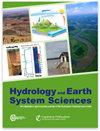Simulated hydrological effects of grooming and snowmaking in a ski resort on the local water balance
IF 5.8
1区 地球科学
Q1 GEOSCIENCES, MULTIDISCIPLINARY
引用次数: 0
Abstract
Abstract. The presence of a ski resort modifies the snow cover at the local scale, due to snow management practices on ski pistes, especially grooming and snowmaking. Snow management exerts 2-fold effects on the local hydrological cycle, through (i) abstraction and transfer of water used for snowmaking, and (ii) changes in water runoff due to added snow mass through snowmaking and/or delayed melting of the snowpack due to snow grooming. This induces a local pressure on water resources, which has seldom been addressed in scientific studies hitherto. Here we introduce a method to compute the hydrological effects of snow management on ski pistes and we apply and illustrate its results for the case study of the La Plagne ski resort in the Northern French Alps. The approach mainly relies on snow cover modelling using the Crocus snow cover driven by SAFRAN reanalysis and climate projections. Model results are evaluated against in-situ hydrological observations and show that the modelling approach, although very simplified for many hydrological processes, provides relevant information and insights in terms of the influence of snow-related processes on water resources. Our study shows a visible impact of grooming, virtually eliminating snowmelt in winter, thus delaying the onset of snowmelt. This results is a lower snowmelt flux during the wintertime, low flow period, on the order of −10 % to −20 %, compensated by higher amounts when snow melts. While about 10 % of the water used for snowmaking is estimated to be lost by evaporation through the ice formation process from the liquid water droplets, we find that, in the case studied, the annual scale alteration of water resources is limited and estimated to be on the order of 1 % to 2 %. This is due to the fact that the amount of water used for snowmaking on ski pistes represents a fraction of 10 % to 20 % of total annual precipitation, that ski pistes cover typically 10 % of the surface area of catchments within which ski resorts are located, and that snowmaking equipment covers, in the case of La Plagne, 40 % of the surface area of ski pistes. Therefore, in this case, snowmaking mainly leads to a moderate shift in snow cover formation and snowmelt processes and plays, for example, a smaller role than the influence of future climate change on mountain hydrology. This study provides an initial overview of the influence of grooming and snowmaking on river flows in a mountain catchment, which can inform future studies on water management and climate change adaptation in areas with ski tourism facilities. This study does not discuss long-term sustainability challenges of ski tourism and other aspects of the local environmental impacts (landscape, biodiversity) of snow management, such as the construction and use of mountain water reservoirs and other earthworks in ski resorts.滑雪场修整和造雪对当地水平衡的模拟水文影响
摘要。滑雪场的存在改变了当地范围内的积雪,这是由于滑雪道的雪管理措施,特别是整理和造雪。雪管理通过(i)用于造雪的水的提取和转移,以及(ii)由于造雪而增加的雪量和/或由于积雪整理而延迟的积雪融化而导致的水径流的变化,对当地水文循环产生双重影响。这对水资源造成了局部压力,迄今为止在科学研究中很少涉及这一问题。本文介绍了一种计算雪道积雪管理水文效应的方法,并将其结果应用于法国北部阿尔卑斯山脉拉普拉涅滑雪场的案例研究。该方法主要依赖于由SAFRAN再分析和气候预测驱动的藏红花积雪覆盖的积雪建模。根据现场水文观测对模型结果进行了评价,结果表明,虽然模型方法对许多水文过程非常简化,但在与雪有关的过程对水资源的影响方面提供了相关信息和见解。我们的研究表明,梳理的明显影响,实际上消除了冬季的融雪,从而推迟了融雪的开始。其结果是,在冬季低流量时期,融雪通量较低,约为- 10%至- 20%,当雪融化时,融雪通量较高。虽然估计约有10%用于造雪的水是由液态水水滴通过冰的形成过程蒸发而损失的,但我们发现,在研究的案例中,水资源的年尺度变化是有限的,估计在1%到2%之间。这是因为滑雪道上造雪的水量只占年总降水量的10%到20%,滑雪道通常覆盖了滑雪胜地所在集水区表面积的10%,而在拉普拉涅,造雪设备覆盖了滑雪道表面积的40%。因此,在这种情况下,造雪主要导致积雪形成和融雪过程的适度转变,其作用小于未来气候变化对山地水文的影响等。本研究初步概述了疏导和造雪对山区集水区河流流量的影响,可为未来有滑雪旅游设施地区的水管理和气候变化适应研究提供信息。本研究没有讨论滑雪旅游的长期可持续性挑战,也没有讨论雪管理对当地环境影响(景观、生物多样性)的其他方面,例如滑雪场的山区水库和其他土方工程的建设和使用。
本文章由计算机程序翻译,如有差异,请以英文原文为准。
求助全文
约1分钟内获得全文
求助全文
来源期刊

Hydrology and Earth System Sciences
地学-地球科学综合
CiteScore
10.10
自引率
7.90%
发文量
273
审稿时长
15 months
期刊介绍:
Hydrology and Earth System Sciences (HESS) is a not-for-profit international two-stage open-access journal for the publication of original research in hydrology. HESS encourages and supports fundamental and applied research that advances the understanding of hydrological systems, their role in providing water for ecosystems and society, and the role of the water cycle in the functioning of the Earth system. A multi-disciplinary approach is encouraged that broadens the hydrological perspective and the advancement of hydrological science through integration with other cognate sciences and cross-fertilization across disciplinary boundaries.
 求助内容:
求助内容: 应助结果提醒方式:
应助结果提醒方式:


